When thinking about your diet, you might wonder how to boost your digestion and health. Foods with Fiber are key. Adding these to your meals can greatly improve your well-being.
Eating a balanced diet with fiber can help your digestive health and overall wellness. With many options, it’s hard to know where to begin. Learning about high fiber foods and fiber rich foods is vital. This knowledge helps you add them to your daily meals easily.
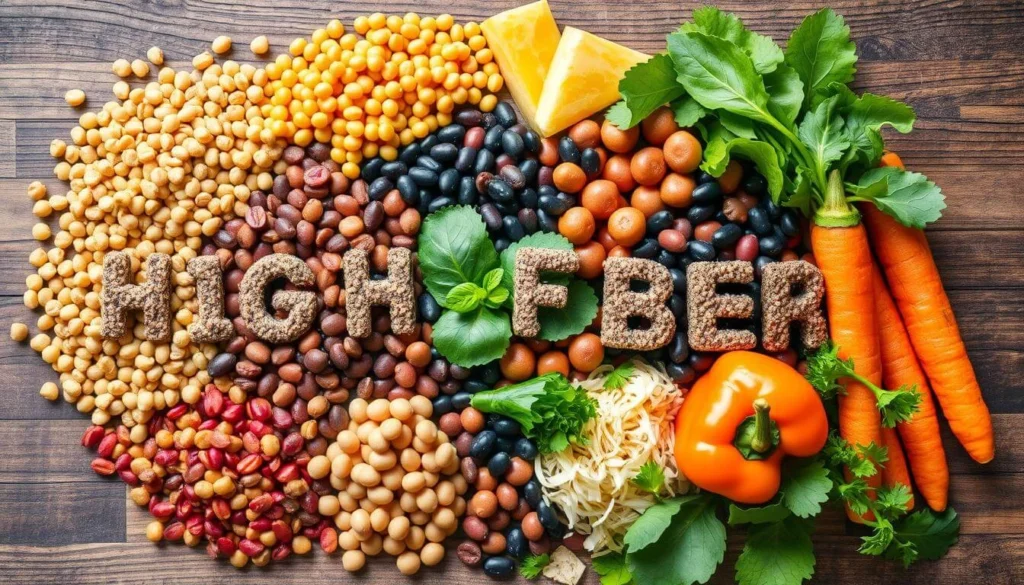
Table of Contents
When it concerns maintaining great digestion health, one nutrient stands out as specifically necessary: fiber. Whether you’re wanting to improve food digestion, handle weight, or enhance overall health and wellness, fiber is your ally. Usually ignored in modern diet regimens, fiber plays a crucial role in keeping the digestion system running smoothly, supporting the digestive tract microbiome, and protecting against a range of digestion problems such as irregularity and bloating.
Fiber isn’t just important for digestion, though. It also offers a riches of wellness benefits beyond the digestive tract, from helping in weight monitoring to supporting heart wellness. Fortunately, obtaining sufficient fiber is simpler than you might assume, as numberous scrumptious and healthy foods are naturally packed with it.
In this blog post, we’ll check out the best foods with fiber that you can consist of in your diet plan to improve your gastrointestinal health and overall wellness. From fiber-rich vegetables and fruits to whole grains and seeds, these foods not just aid your digestion but likewise offer many wellness benefits. Ready to start feeling your best? Let’s dive in!
Key Takeaways
- Incorporating food with fiber into your diet can improve digestion and overall health
- High fiber foods and fiber rich foods can support digestive health and overall wellness
- Eating a balanced diet with a variety of food with fiber is essential for overall well-being
- Learning about different types of high fiber foods and fiber rich foods can help you make informed choices
- Adding fiber rich foods to your meals can have a significant impact on your health
Why Fiber is Essential for Better Digestion
What is Fiber?
Dietary fiber is a type of carbohydrate found in plant-based foods that your body cannot digest or absorb. Unlike fats, proteins, or sugars, fiber passes through the digestive system relatively intact. It comes in two main types:
- Soluble Fiber: Dissolves in water to form a gel-like substance. This type of fiber is found in foods like oats, apples, citrus fruits, and beans. Soluble fiber helps to regulate blood sugar levels, lower cholesterol, and improve digestion by softening stools.
- Insoluble Fiber: Does not dissolve in water. Instead, it adds bulk to stool and helps food move more efficiently through the digestive tract. You can find insoluble fiber in whole grains, nuts, seeds, and the skins of fruits and vegetables.
Both types of fiber play crucial roles in keeping your digestive system functioning smoothly.
How Fiber Supports Gut Health
Fiber is essential for nurturing a healthy gut microbiome—the community of bacteria that lives in your digestive tract. Soluble fiber acts as a prebiotic, feeding beneficial gut bacteria, which in turn produce short-chain fatty acids (SCFAs). These SCFAs help reduce inflammation, strengthen the gut lining, and improve overall gut health.
Insoluble fiber, on the other hand, aids in regulating bowel movements by promoting stool regularity and preventing sluggish digestion. Together, soluble and insoluble fiber create a harmonious balance, keeping your digestive system healthy and efficient.
The Link Between Fiber and Digestion Issues
A diet lacking in fiber can lead to common digestive problems such as:
- Constipation: Insoluble fiber increases stool bulk and helps it move through the intestines more easily, reducing constipation.
- Bloating: While fiber may initially cause some bloating as your body adjusts, over time it improves digestion and reduces gas.
- Irritable Bowel Syndrome (IBS): Many people with IBS benefit from soluble fiber, which soothes the digestive tract and minimizes symptoms like diarrhea or cramping.
By gradually increasing your fiber intake and drinking plenty of water, you can alleviate these issues and enjoy a healthier digestive system. Fiber isn’t just essential for digestion—it’s the foundation of a strong and resilient gut.
Understanding the Importance of Dietary Fiber
When you dive into nutrition, you might hear about “dietary fiber” and its role in a healthy gut. A fiber rich diet is key for your overall health. It’s important to know about the different types of fiber and their benefits. Foods like fruits, veggies, and whole grains are great sources of fiber.
To follow a fiber rich diet, add foods high in fiber to your meals. Legumes, nuts, and seeds are good examples. A balanced diet with plenty of fiber helps your digestive system stay healthy.
Soluble vs. Insoluble Fiber
Soluble fiber dissolves in water and can lower cholesterol. Insoluble fiber doesn’t dissolve in water and helps with bowel movements. Both are vital for a healthy gut.
Daily Recommended Fiber Intake
The amount of fiber you should eat daily depends on your age and sex. Aim for 25-30 grams of fiber each day. You can get more fiber by eating more fruits, veggies, and whole grains.
How Fiber Supports Digestive Health
A fiber rich diet boosts digestive health. It helps with regular bowel movements, prevents constipation, and lowers disease risk. By focusing on fiber sources and eating more fiber-rich foods, you can keep your digestive system in top shape.
The Connection Between Fiber and Overall Wellness
Exploring the benefits of a high fiber diet is key. It’s vital to see how fiber affects your health. A diet full of fiber supports a healthy digestive system and boosts overall wellness.
By eating more fiber, you can enjoy better digestion, less inflammation, and a stronger immune system. This is thanks to the many benefits of a high fiber diet.
Some of the key benefits of a high fiber diet include:
- Supporting healthy blood sugar levels
- Promoting healthy cholesterol levels
- Aiding in weight management
- Supporting healthy gut bacteria
When adding high fiber foods to your diet, start slow. This lets your digestive system adjust. Begin with fruits, vegetables, and whole grains in your meals.
As you eat more fiber, drink plenty of water. This helps prevent constipation and supports healthy gut bacteria. Making smart diet choices can greatly improve your health and wellness.
Understanding the role of fiber in your diet is a big step towards better health. A high fiber diet supports your overall wellness and sets you up for long-term health. So, why not start today and enjoy the many benefits of a high fiber diet?
Best Fruits High in Fiber
Fruits are a great choice for fiber. They taste good and are full of nutrients. Eating foods high in fiber can help your digestion and overall health.
Many fruits are good sources of fiber. Berries, tropical fruits, and dried fruits are all good options. They can add fiber and important nutrients to your meals and snacks.
Berries and Their Fiber Content
Berries like raspberries, strawberries, and blueberries are high in fiber. For example, one cup of raspberries has about 4 grams of fiber. You can eat them as a snack, mix them into oatmeal or yogurt, or blend them into smoothies.
Tropical Fruits for Fiber Intake
Tropical fruits like mangoes, pineapples, and papayas are also good for fiber. A medium mango has about 2.6 grams of fiber. They’re great in salads, smoothies, or as a fresh snack.
Dried Fruits as Fiber Sources
Dried fruits, such as apricots, prunes, and raisins, are packed with fiber. For example, a quarter cup of dried apricots has about 3 grams of fiber. Enjoy them as a snack or add them to your favorite recipes for extra fiber.
Eating these fiber-rich foods can help your digestion and overall health. Try different fruits to get a variety of nutrients and fiber.
Top Vegetables Rich in Fiber
Vegetables are a great choice for high fiber foods. They are full of fiber, vitamins, minerals, and antioxidants. Eating a variety of vegetables can boost your digestive health and overall wellness.
To boost your fiber intake, try these vegetables:
- Broccoli: rich in soluble fiber, which can help lower cholesterol levels
- Carrots: high in insoluble fiber, which can help promote regular bowel movements
- Brussels sprouts: a good source of both soluble and insoluble fiber
Adding these veggies to your meals is easy and tasty. Roast or steam them as a side dish. Or, toss them into your favorite soups and stews. Simple changes can make a big difference in your health.
Whole Grains as Essential Food with Fiber
Whole grains are a top pick for fiber. They’re packed with fiber, making them a key part of a healthy diet. You can find them in many forms, like ancient grains and modern whole grain options. Adding these fiber-rich foods to your meals can boost your digestive health and overall well-being.
Whole grains are full of nutrients like vitamins, minerals, and antioxidants. They’re a great choice for anyone wanting to improve their health. Foods like brown rice, quinoa, and whole wheat bread are all high in fiber. They help with digestion, keep you feeling full, and can even lower cholesterol.
Whole grains are known for their high fiber content. This helps with regular bowel movements and prevents constipation. They’re also packed with iron, B vitamins, and selenium, making them a nutritious choice. Adding whole grains to your diet can bring many health benefits and support a healthier lifestyle.
Ancient Grains and Their Fiber Content
Ancient grains like Kamut and Spelt are rich in fiber and nutrients. They’ve been around for thousands of years and are full of fiber, vitamins, and minerals. You can use them in many dishes, from salads to baked goods, making them a great addition to a healthy diet.
Modern Whole Grain Options
There are also many modern whole grain options available. These include whole wheat bread, brown rice, and quinoa. These foods are not only high in fiber but also in nutrients, making them a healthy choice. They can be used in various dishes, from breakfast to dinner, and are a great part of a healthy diet.
Legumes and Pulses for Maximum Fiber
Exploring high fiber foods to boost your fiber intake leads to legumes and pulses. These foods are not only high in fiber but also full of nutrients. They are a fantastic addition to a fiber rich diet. Legumes like lentils, chickpeas, and black beans are versatile and can be cooked in many ways. This helps to increase their fiber and nutritional value.
Some of the best legumes and pulses for fiber include:
- Lentils: With about 16 grams of fiber per 1 cup cooked, lentils are an excellent source of fiber.
- Chickpeas: 1 cup cooked chickpeas contain around 12 grams of fiber.
- Black beans: These beans provide about 9 grams of fiber per 1 cup cooked.
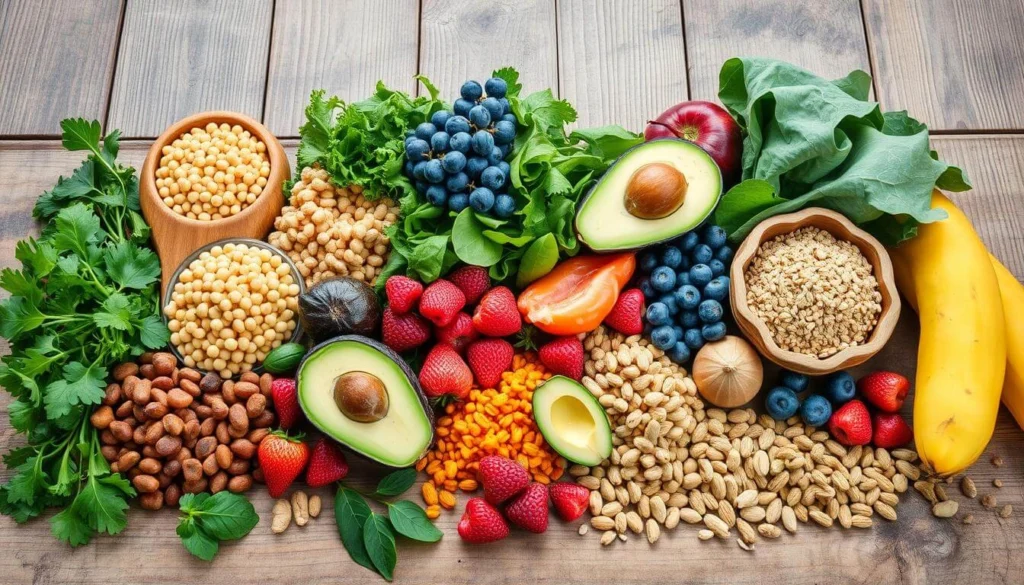
Adding legumes and pulses to your diet can greatly improve your digestive health and overall wellness. By choosing these high fiber foods, you support healthy digestion and feel full longer. They also help manage blood sugar levels. Remember to stay hydrated and listen to your body as it adjusts to more fiber.
Nuts and Seeds: Compact Fiber Sources
Nuts and seeds are often seen as small but mighty fiber sources. They pack a lot of fiber into a tiny package. You can easily add them to oatmeal, yogurt, or salads to boost your fiber intake.
Best Nuts for Fiber Content
Almonds, pistachios, and hazelnuts are top choices for fiber. They’re also full of healthy fats and protein. For example, a small handful of almonds gives you about 3.5 grams of fiber.
Seed Varieties and Their Benefits
Chia seeds, flaxseeds, and hemp seeds are great fiber sources. You can mix them into smoothies, baked goods, or use them as a salad topping. Chia seeds, in particular, are a fiber powerhouse, with about 10 grams per ounce.
Adding these fiber rich foods to your diet can help your digestive health and overall well-being. Opt for unsalted and unsweetened options to get the most nutritional benefits from these fiber sources.
How to Incorporate More Fiber-Rich Foods Into Your Diet
To boost your fiber intake, begin with small changes in your meals and snacks. Add high fiber foods like fruits, veggies, whole grains, and legumes to your diet. A fiber rich diet supports your digestive health and overall wellness.
Here are some tips to help you add more fiber-rich foods to your diet:
- Start your day with a high-fiber breakfast, such as oatmeal with fruits and nuts
- Snack on fruits and vegetables throughout the day
- Choose whole grains over refined grains for your meals
- Incorporate legumes, such as beans and lentils, into your meals
Remember to increase your fiber intake slowly. A sudden jump in high fiber foods can upset your stomach. By making smart food choices, you can improve your digestive health and overall wellness with a fiber rich diet.
Potential Side Effects of Increasing Fiber Intake
When you add new fiber sources to your diet, knowing the possible side effects is key. As you eat more fiber rich foods, your body might react differently. Some might feel bloated or gassy because of the sudden fiber boost.
To avoid discomfort, listen to your body and make slow changes to your diet. Start by adding small amounts of fiber rich foods to your meals. Then, slowly increase the amounts. This lets your digestive system get used to the new fiber sources.
- Start with small portions and gradually increase the amount
- Drink plenty of water to help with digestion
- Choose a variety of fiber sources to ensure you’re getting a balanced intake
By being aware of side effects and making slow changes, you can enjoy the benefits of a high-fiber diet. This can improve your overall health.
Smart Tips for Transitioning to a High-Fiber Diet
When you start a high fiber diet, do it slowly. This lets your body get used to it. Too much fiber intake at once can cause discomfort. So, it’s important to choose your foods wisely.
Begin by adding more high fiber foods to your meals. Think whole grains, fruits, and veggies. Legumes, nuts, and seeds are good too. Try to up your fiber intake by 2-3 grams each day.
Drinking enough water is key when you’re on a fiber rich diet. Water helps fiber move through your body, preventing constipation. Drink at least 8 cups of water a day. If you’re active, you might need more.
- Eating a variety of high fiber foods to ensure you’re getting a range of nutrients
- Being mindful of portion sizes to avoid overconsumption of fiber rich foods
- Listening to your body and adjusting your fiber intake as needed
Combining Fiber-Rich Foods for Maximum Benefits
To get the most from fiber sources, mix different fiber rich foods in your meals. This way, you can make a balanced diet that helps your digestion and health. Foods high in fiber can be combined in many ways for the best nutrition.
Start by finding various fiber sources and adding them to your meals. For instance, pair whole grains with fiber rich foods like fruits and veggies. Legumes, nuts, and seeds are also great foods high in fiber to add to your diet.
- Legumes, such as beans and lentils, are excellent fiber sources and can be added to soups, stews, and salads.
- Nuts and seeds, like almonds and chia seeds, are fiber rich foods that can be snacked on or added to oatmeal or yogurt.
By mixing these foods high in fiber, you can make a diet that boosts your health and well-being. Don’t forget to drink plenty of water and listen to your body as you increase your fiber intake.
Special Considerations for Different Dietary Needs
Adding high fiber foods to your diet is key. But, it’s important to think about your own needs. A diet rich in fiber is great, but it must fit your lifestyle. Whether you’re gluten-free, vegetarian, or vegan, there are many options to meet your fiber needs.
Gluten-Free High-Fiber Options
If you can’t have gluten, don’t worry. There are many gluten-free foods high in fiber. Here are a few:
- Brown rice
- Quinoa
- Gluten-free oats
These foods are not just high in fiber. They also have protein and healthy fats.
Vegetarian and Vegan Considerations
Vegetarians and vegans can also enjoy a fiber-rich diet. Here are some good options:
- Legumes like lentils and chickpeas
- Nuts and seeds like almonds and chia seeds
- Whole grains like brown rice and quinoa
By considering your dietary needs and adding high fiber foods, you can boost your digestive health. Remember to drink plenty of water and listen to your body. This will help you smoothly transition to a fiber-rich diet.
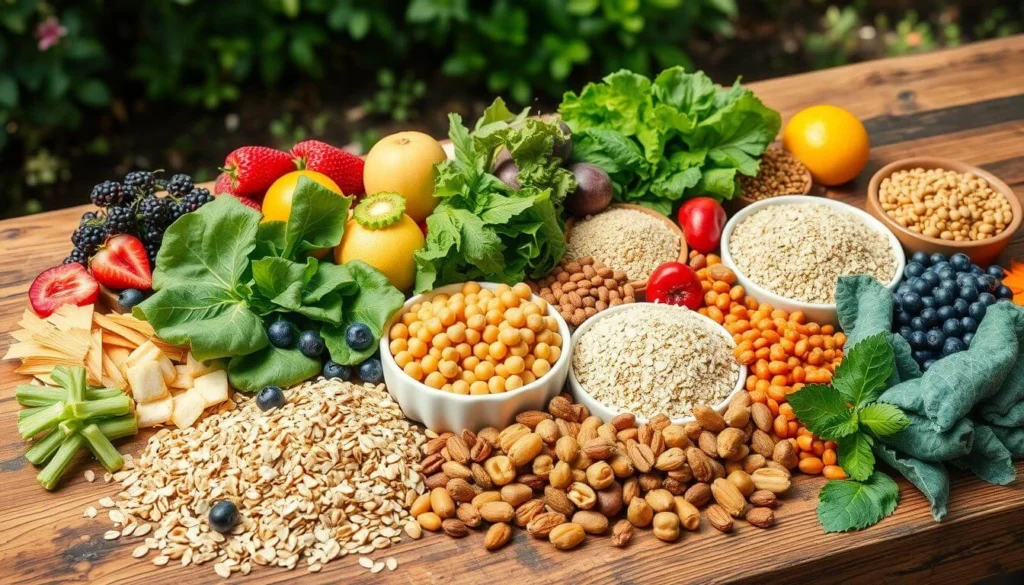
Shopping and Storage Tips for Fiber-Rich Foods
Adding fiber sources to your diet is important. Knowing how to shop and store them right is key. Freshness helps keep the fiber and nutrients in fiber rich foods at their best. You can find many foods high in fiber at your local store, like fruits, veggies, whole grains, and legumes.
Here are some tips for smart grocery shopping:
- Go for fresh, seasonal produce for the most fiber
- Keep fiber rich foods in a cool, dry spot to keep them good
- Freeze or can foods high in fiber to enjoy all year
Following these tips helps your digestive health and overall well-being. Always check the expiration dates and packaging of fiber sources for the best nutrition.
Conclusion: Embracing a Fiber-Rich Lifestyle for Better Health
Adding high fiber foods to your diet can really change your health for the better. By focusing on fiber-rich nutrition, you help your digestive system, keep blood sugar levels stable, and even support heart health.
Start by slowly adding more fiber to your meals. Try different fiber-rich foods to see what you like. Don’t forget to drink plenty of water and listen to your body as it gets used to the changes. With a bit of effort, you can easily make a fiber-rich diet a part of your life.
Start this journey to better health and let this article guide you. Your body will be grateful for the fiber-rich nutrition it needs. You’ll feel more energetic, satisfied, and in control as you move towards a healthier life.
FAQ
What are the benefits of a high-fiber diet?
A high-fiber diet can improve digestion and blood sugar control. It also lowers heart disease risk and aids in weight management. Fiber keeps your digestive system working right, makes you feel full, and boosts overall health.
What are the best sources of dietary fiber?
Fruits, vegetables, whole grains, legumes, nuts, and seeds are top fiber sources. High-fiber foods include berries, avocados, broccoli, lentils, quinoa, and chia seeds.
How much fiber should I be getting daily?
Adults should aim for 25-30 grams of fiber daily. Your needs may vary based on age, gender, and health. Start slowly and talk to a doctor if you’re unsure.
What is the difference between soluble and insoluble fiber?
Soluble fiber dissolves in water, aiding digestion and blood sugar control. Insoluble fiber adds bulk to stool, promoting regular bowel movements. Both are vital for digestive health.
How can I incorporate more fiber-rich foods into my diet?
To boost fiber, eat more fruits and veggies, choose whole grains, and add legumes and lentils. Snack on nuts and seeds. Gradually increase fiber to help your body adjust.
Are there any potentially side effects of increasing fiber intake?
Too fast a fiber increase can cause gas, bloating, or discomfort. Gradually increase fiber and drink plenty of water. If issues persist, see a doctor.
How can I combine fiber-rich foods for maximum benefits?
Mix different fiber-rich foods for a variety of nutrients. Try fruits and veggies with whole grains or nuts and seeds in meals. Find the best combinations for you.
Are there any special considerations for specific dietary needs?
Yes, there are fiber-rich options for gluten-free, vegetarian, or vegan diets. Look for alternative grains, legumes, and plant-based foods to meet your needs.
How should I store fiber-rich foods to maintain their nutritional value?
Proper storage keeps fiber and nutrients in your foods. Store fruits and veggies in the fridge, whole grains in airtight containers, and nuts and seeds in a cool, dry place. Good storage maximizes fiber benefits.

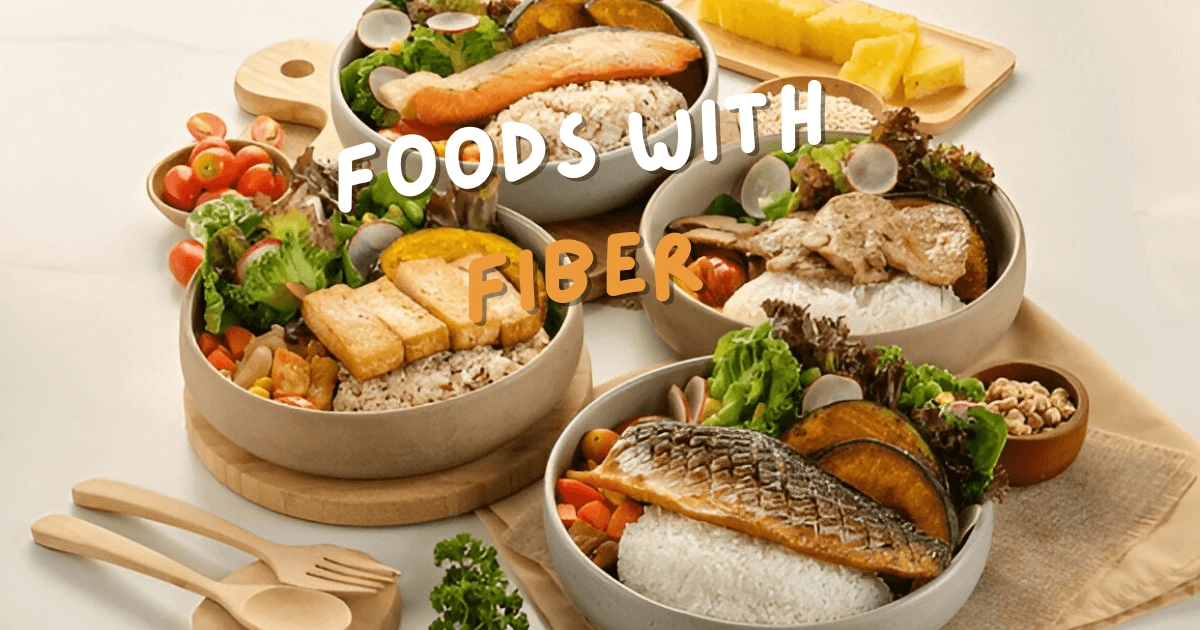

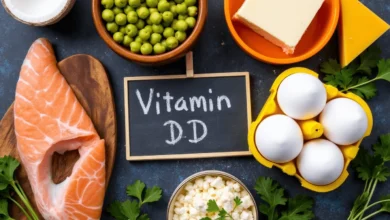
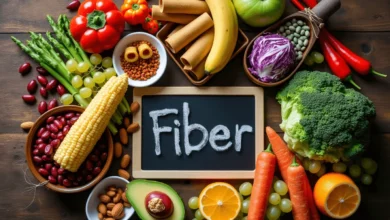
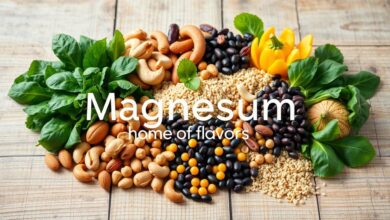
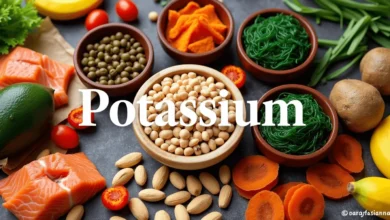
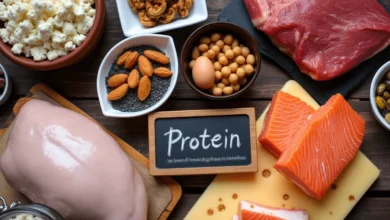
One Comment